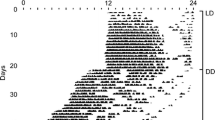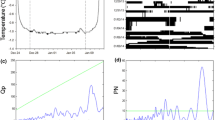Summary
The timing mechanism underlying ultradian (2–3 h) activity patterns in the common vole, Microtus arvalis, was studied using behavioural deprivation experiments. These were aimed at distinguishing between a homeostatic control mechanism, in which the rhythmic behaviour itself is part of the causal loop, and a clock mechanism, independent of the behaviour.
In 175 experiments, deprivation of food during 3 ultradian cycles in (subjective) daytime did not result in significant changes in the ultradian periodicity of attempts to obtain the food, compared with ad lib. access to food and water. A minor, but significant increase in ultradian activity time (α′) occurred in the course of the deprivation, but this was compensated by a shorter ultradian rest (ϱ′). These results were obtained both in intact animals (n = 24), which showed ultradian and circadian rhythmicity in behaviour, and in animals (n = 21) with electrolytic lesions aimed at the suprachiasmatic nuclei (SCN), which lacked the circadian modulation of behaviour. Simultaneous deprivation of water and food in 8 voles without circadian rhythmicity during 40 experiments also did not lead to any change in the ultradian periodicity of feeding attempts.
Rest deprivation was studied in 5 SCN lesioned voles, by forcing running wheel activity to continue following spontaneous running. Thus, the experimental activity bout α′ was artificially lengthened to 2–9 h in 67 experiments. The onset of the subsequent rest episodes occurred independent of the duration of the preceding α′. The duration of ϱ′ was dependent on the preceding, experimental α′ in a periodic fashion. The interval experimental τ′ (=lengthened α′+following ϱ′) was equal to one, two or three times the control τ′ (obtained on nonexperimental days). This result fits the prediction of a clock model and is in conflict with a monotonicincrease of ϱ′ with α′, as expected in a homeostatic, restorative process.
It is concluded that the ultradian timing of activity in the common vole can be explained neither by homeostatic hunger or thirst mechanisms nor by homeostatic rest/activity regulation. The results strongly suggest an independent clock system generating ultradian feeding rhythms in the common vole.
Similar content being viewed by others
Abbreviations
- DD :
-
continuous darkness
- LD :
-
light-dark regime
- LL :
-
continuous light
- RCA :
-
retrochiasmatic area
- ARC :
-
arcuate nucleus
- SCN :
-
suprachiasmatic nuclei
- τ′:
-
ultradian period
- α′:
-
ultradian activity time
- ϱ′:
-
ultradian rest time
References
Daan S (1987) Clocks and hourglass timers in behavioural cycles. In: Hiroshige T, Honma K (eds) Comparative aspects of circadian clocks. Hokkaido University Press, Sapporo, pp 42–54
Daan S, Aschoff J (1981) Short-term rhythms in activity. In: Aschoff J (ed) Handbook of behavioral neurobiology, vol 4. Plenum, New York, pp 491–498
Daan S, Beersma DGM, Borbély AA (1984) Timing of human sleep: recovery process gated by a circadian pacemaker. Am J Physiol 246:161–178
Daan S, Slopsema S (1978) Short-term rhythms in foraging behaviour of the common vole, Microtus arvalis. J Comp Physiol 127:215–227
Davis DHS (1933) Rhythmic activity in the short-tailed vole, Microtus. J Anim Ecol 2:232–238
Dijk DJ, Beersma DGM (1989) Effects of SWS deprivation on subsequent EEG power density and spontaneous sleep duration. Electroenceph Clin Neurophysiol 72:312–320
Dijk DJ, Daan S (1989) Sleep EEG spectral analysis in a diurnal rodent: Eutamias Sibiriens. J Comp Physiol A 165:205–219
Gerkema MP, Daan S (1985) Ultradian rhythms in behaviour: the case of the common vole (Microtus arvalis). Exp Brain Res [Suppl] 12:11–31
Gerkema MP, Groos GA, Daan S (1990) Differential elimination of circadian and ultradian rhythmicity by hypothalamic lesions in the common vole, Microtus arvalis. J Biol Rhythms 5:81–95
Hatfield DM (1940) Activity and food consumption in Microtus and Peromyscus. J Mammal 21:29–36
Hoogenboom I, Daan S, Dallinga JH, Schoenmakers M (1984) Seasonal change in the daily timing of behaviour of the common vole, Microtus arvalis. Oecologia 61:18–31
LeMagnen J (1983) Body energy balance and food intake: a neuroendocrine regulatory mechanism. Physiol Rev 63:314–386
Lehmann U (1976) Short term and circadian rhythms in the behaviour of the vole, Microtus agrestis (L.) Oecologia 23:185–199
Madison DM (1985) Activity rhythms and spacing. In: Tamarin RH (ed) Biology of new world Microtus. Am Soc Mammol Spec Publ 8:373–419
Richter CP (1927) Animal behavior and internal drives. Q Rev Biol 2:307–343
Rusak B (1989) The mammalian circadian system: models and physiology. J Biol Rhythms 4:121–134
Sokolove PG, Bushell WN (1978) The chi-square periodogram: its utility for analysis of circadian rhythms. J Theor Biol 74:131–160
Stebbins LL (1975) Short activity periods in relation to circadian rhythms in Clethrionomys gapperi. Oikos 26:32–38
Strubbe JH, Keyser J, Dijkstra T, Prins AJA (1986) Interaction between circadian and caloric control of feeding behavior in the rat. Physiol Behav 36:489–493
Trachsel L, Tobler I, Borbély AA (1988) Electroencephalogram analysis of non-rapid eye movement sleep in rats. Am J Physiol 255:R27-R37
Author information
Authors and Affiliations
Rights and permissions
About this article
Cite this article
Gerkema, M.P., van der Leest, F. Ongoing ultradian activity rhythms in the common vole, Microtus arvalis, during deprivations of food, water and rest. J Comp Physiol A 168, 591–597 (1991). https://doi.org/10.1007/BF00215081
Accepted:
Issue Date:
DOI: https://doi.org/10.1007/BF00215081




